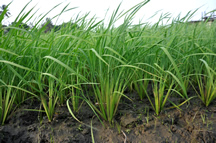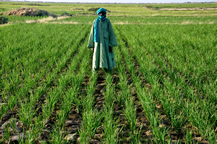Feature Article - June 2014
SRI-RICE TO TAKE PART IN STUDY ON THE POTENTIAL OF THE SYSTEM OF RICE INTENSIFICATION TO REDUCE ARSENIC IN RICE
Rice is the staple food for half the world’s population. Since most rice is grown in flooded fields where it consumes a quarter to a third of global fresh water, rice is susceptible to the accumulation of arsenic that is mobile in flooded soils. Arsenic is not only toxic to rice plants, but can lead to a number of health problems in humans, including cancer. The research project  “Reducing Inorganic Arsenic Levels in Rice by Appropriate Water Management,” which addresses this issue, was among twelve successful proposals selected by the David R. Atkinson Center for a Sustainable Future to receive funding from the 2014 Academic Venture Fund (See ACSF abstract). The System of Rice Intensification, which recommends moist, rather than flooded fields, is one of the water management regimes will be investigated in regards to its potential to reduce arsenic content in rice (See photo at right from SRI field in Liberia).
“Reducing Inorganic Arsenic Levels in Rice by Appropriate Water Management,” which addresses this issue, was among twelve successful proposals selected by the David R. Atkinson Center for a Sustainable Future to receive funding from the 2014 Academic Venture Fund (See ACSF abstract). The System of Rice Intensification, which recommends moist, rather than flooded fields, is one of the water management regimes will be investigated in regards to its potential to reduce arsenic content in rice (See photo at right from SRI field in Liberia).
The goal of the project is to save water whil e ensuring higher long-term yields and producing a safer, more nutritious crop of the world’s most important staple food. Cornell investigators on the award are Louis Derry (Earth and Atmospheric Sciences), Beth Ahner (Biological and Environmental Engineering), John Duxbury (Crop and Soil Science), and Erika Styger (SRI-Rice, International Programs, College of Agriculture and Life Sciences).
Why Study Arsenic?
Due to its flooded cultivation, even rice grown in areas that are not contaminated by arsenic has about ten times more arsenic than other cereals grains. The concern about arsenic in rice, initially focused on rice from arsenic-affected areas in Asia, has now evolved into a broader debate on dietary arsenic exposure via rice, and will likely result in an international  maximum level for arsenic in rice being established by the World Health Organization.
maximum level for arsenic in rice being established by the World Health Organization.
In flooded soils, arsenic is readily released and available for plant uptake. By contrast, the mobility of arsenic is significantly restricted in aerated soils. Management practices that are less water-intense, such as those adopted under SRI (see photo from Mali at left) and other management systems that include Alternate Wetting and Drying (AWD), therefore constitute a promising means for reducing arsenic levels in rice.
The human health risks associated with exposure to arsenic via rice consumption depends strongly on the chemical speciation of arsenic in the rice grain -- inorganic arsenic species being considerably more toxic than organic arsenic compounds. This makes it crucial to understand how water management impacts both total arsenic content and arsenic speciation in rice.
Impacts of the Research
The research team at Cornell will collaborate with overseas partners to test reduced water-use practices associated with SRI in order to determine whether arsenic can be reduced in rice across a range of soils, while maintaining yields. Erika Styger (SRI-Rice), John Duxbury (CSS) and Linda Roberts will facilitate on-station research trials with partners in seven sites Africa and Asia as well as collection in farmers’ fields. As arsenic is present in different forms with differing levels of toxicity, Louis Derry (EAS) and Beth Ahner (BEE) at Cornell must first establish analytical procedures to determine arsenic speciation in rice grain.
The research will contribute to a better understanding of the impact of paddy field water management on the nutritional quality of rice; specifically on arsenic content and type. The researchers ultimately hope to identify water management practices that can be recommended for adoption in arsenic-affected areas, as well as in any rice cultivation system where the production of rice low in inorganic arsenic is considered a priority.
For more information about the project, contact Erika Styger (eds8ATcornell.edu) or Linda Roberts (lcr59ATcornell.edu).

